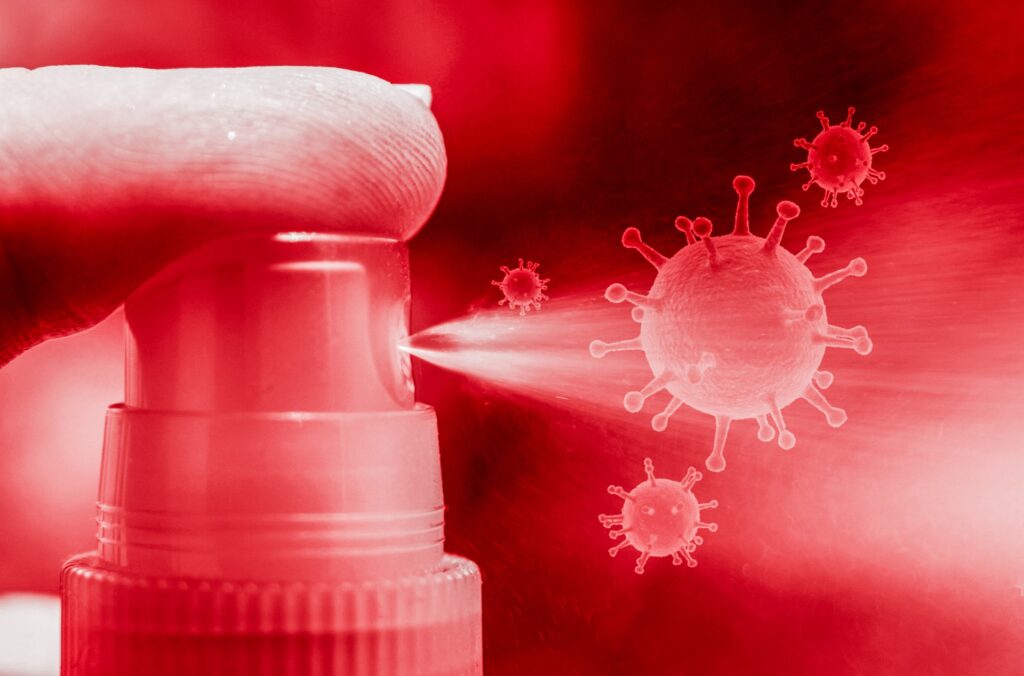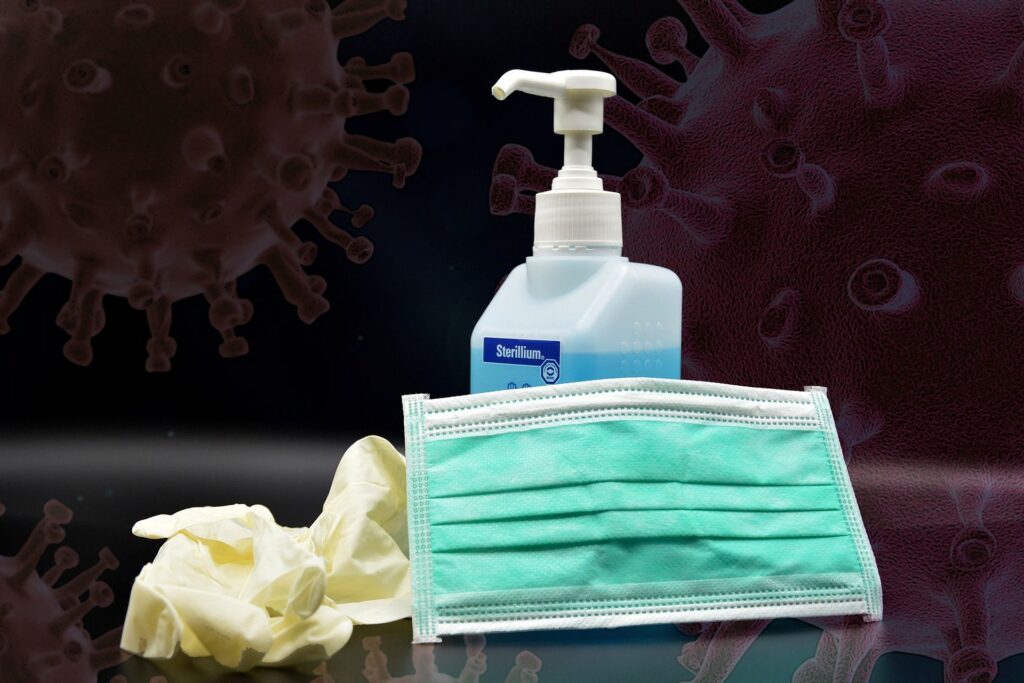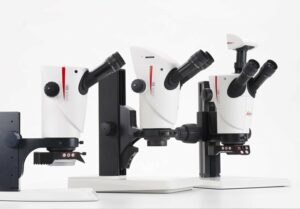We know that as we slowly go back to normal and back into our workplaces that decontamination, deep cleaning, and/or sanitization is paramount. Also, we know that you are possibly sharing your microscope with colleagues and you are more aware than ever of contamination. A few things you can do is:
- Frequent sanitization of the microscope
- Use disposable gloves for microscope operation, cleaning and decontamination
- Disposable gloves should be decontaminated or should be changed frequently
The main user contact points should be decontaminated often such as eyepieces, focus knob, microscope body, computer keyboard and mouse. In other environments, heat is the most efficient disinfection method such as exposing a material to a flame, steam or boiling it in water. Of course, this would damage your microscope. In your lab, you can commonly clean your lab instruments and surfaces with liquids containing alcohols, aldehydes, chlorine compounds, phenols, and peroxides. The efficiency of any of these liquids depends on its concentration and contact time with the material.
Not all components and material of your microscope can resist chemicals such as rubbers, glues, plastic components, or surface coatings of optical components. These can all be adversely affected by certain disinfectants.
The Disinfectants
Alcohols (ethanol, isopropyl alcohol) are most effective against vegetative bacteria but are known to have an adverse effect on rubber and some plastics.


Aldehydes are potent disinfectants but certain aldehydes, such as formaldehyde, are harmful and cause respiratory problems and skin irritations being some of the side effects. We don’t suggest using formaldehyde, formalin, or other aldehydes on your microscopes as a cleaner but if you must, the system should be completely covered. Your microscope optics are extremely sensitive and need to be protected against harmful reagents so if your workplace does complete room disinfection, we recommend covering or unmounting the optics and cleaning them manually. To avoid damaging your optics, always follow the cleaning instructions for the microscope in the specified manual.
Chlorine compounds kill vegetative bacteria and viruses. The most common chlorine compound for disinfection is hypochlorite, otherwise known as household bleach. For this to be the most effective in disinfection, a pH of 6-8 is optimum and a concentration of 0.5 to 1% sodium hypochlorite is required.
Hydrogen Peroxide is a great disinfectant that kills vegetative bacteria and viruses but only in concentrations higher than 3%. Although, in higher concentrations, it is harmful and will affect anodized metal finishes such as brass and should not be used on surfaces and special coatings of objective lenses.
So now that we’ve got some information on reagents, what do we recommend for sanitizing your microscope?
Sanitizing Your Microscope
Referring to the SDS of the components you plan to use is important.
ALWAYs put YOUR safety first!
This is especially important now more than ever. Now let’s get started…
All surfaces of your microscope (widefield, confocal, or stereo) system should be able to handle up to 10% hydrogen peroxide solutions, alcohols, and soft cleaning reagents. For cleaning or decontamination, using extensive moist wipe disinfection with the reagents mentioned below is recommended.

With your disinfectant, you need cotton swabs (wool buds), optical cloths, lens cleaning paper, and latex or non-latex gloves as all of these items are disposable.
Regular cleaning with alcohol-based disinfection wipes or soft tissues moistened with alcohol-based disinfectants will help keep your microscope and workstation clean between users.
Chlorine
Suggested Disinfection: Chlorine, in the form of sodium hypochlorite or other chlorine releasing compounds, with a pH of 6-8 is optimum and a concentration of 0.5% to 1% sodium hypochlorite is required. The effective decontamination of prions is a 1:5 to 1:10 dilution of sodium hypochlorite (meaning 5.25% -6.15% sodium hypochlorite provides 10,500-12,300 ppm chlorine).
Cleaning: For hypochlorite solutions, you should have it in contact with a surface for at least 10 minutes. For diluted sodium hypochlorite solutions, they should be left on for at least 15 minutes to disinfect surfaces.
Then for either application, rinse with distilled water afterwards and let the instrument dry.
Note: if you are using a Leica microscope, sodium hypochlorite and other chlorine releasing compounds are outside of the manufacturer’s recommended uses.
Hydrogen Peroxide
Suggested Practice Before Disinfection: you may have noticed that some microscope systems have openings for air cooling which shouldn’t be covered. If the air becomes contaminated during the use of the microscope system, the contaminated air could flow into the device when the cooling fans are operating. If room decontamination with hydrogen peroxide is planned, the systems should be unplugged and fully disconnected from any power source. Once shut off and without power, and then the vaporized aerosol can enter inside the device as it should not cause condensation.
Suggested Disinfection: Hydrogen Peroxide with a 3% concentration is recommended to kill vegetative bacteria, viruses, and fungi.
Cleaning: Put hydrogen peroxide in contact with surfaces for at least 10 minutes. Afterwards, rinse with distilled water and let the instrument dry.
 Other Ideas Outside of Cleaning Your Microscope
Other Ideas Outside of Cleaning Your Microscope
- Cover all points of contact that are prone to contamination with a plastic film before you use your microscope. Afterwards, the plastic film can be either decontaminated or exchanged with clean ones.
- Using gloves to avoid infection is recommended and can be decontaminated with alcohol if necessary but we suggest changing them after use to minimize the risk of contamination.
Other Information
Never use abrasive compounds or cleaners. Abrasive compounds can scratch surfaces and have a negative effect on the protective coating of your microscope parts.
Referring to the instruction manual of your microscope is suggested especially for cleaning accessible optical components (such as the front lens of objectives). The manual will have the proper information on cleaning optical components or if you have a Leica microscope try here.
Internal optical components and filter cubes in a microscope must be cleaned only by service technicians. Our service department can help you out in that case.
